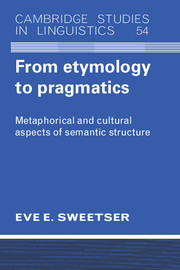
-
Select format
-
- Publisher:
- Cambridge University Press
- Publication date:
- June 2012
- March 1990
- ISBN:
- 9780511620904
- 9780521424424
- Dimensions:
- Weight & Pages:
- Dimensions:
- (228 x 152 mm)
- Weight & Pages:
- 0.23kg, 188 Pages
You may already have access via personal or institutional login
Book description
This book offers a distinct approach to the analysis of the multiple meanings of English modals, conjunctions, conditionals and perception verbs. Although such ambiguities cannot easily be accounted for by feature-analyses of word meaning, Eve Sweetser's argument shows that they can be analysed both readily and systematically. Meaning relationships in general cannot be understood independently of human cognitive structure, including the metaphorical and cultural aspects of that structure. Sweetser shows that both lexical polysemy and pragmatic ambiguity are shaped by our metaphorical folk understanding of epistemic processes and of speech interaction. Similar regularities can be shown to structure the contrast between root, epistemic and 'speech-act' uses of modal verbs, multiple uses of conjunctions and conditionals, and certain processes of historical change observed in Indo-European languages. Since polysemy is typically the intermediate step in semantic change, the same regularities observable in polysemy can be extended to an analysis of semantic change. This book will attract students and researchers in linguistics, philosophy, the cognitive sciences, and all those interested in metaphor.
Contents
Metrics
Altmetric attention score
Full text views
Full text views help Loading metrics...
Loading metrics...
* Views captured on Cambridge Core between #date#. This data will be updated every 24 hours.
Usage data cannot currently be displayed.
Accessibility standard: Unknown
Why this information is here
This section outlines the accessibility features of this content - including support for screen readers, full keyboard navigation and high-contrast display options. This may not be relevant for you.
Accessibility Information
Accessibility compliance for the PDF of this book is currently unknown and may be updated in the future.


